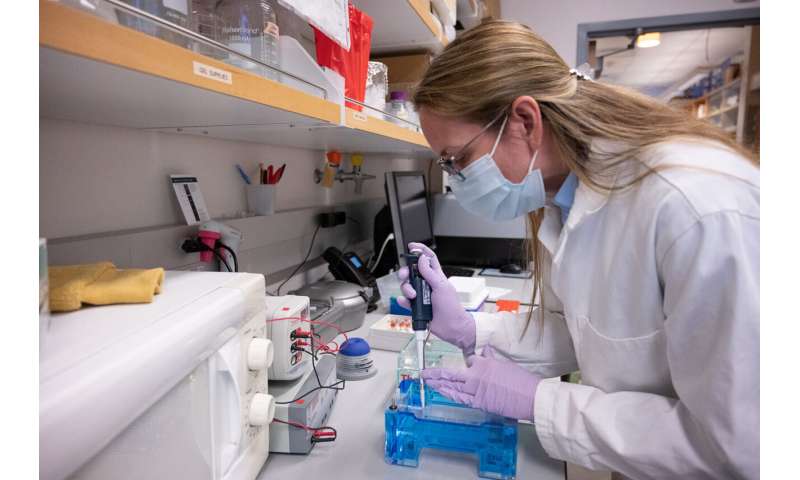
A vaccine first introduced in the late 1700’s could help researchers today looking for a way to fight the coronavirus. Dr. Amy MacNeill, a veterinary pathologist at Colorado State University, and her team are using the vaccinia virus—used as the very first vaccine, for smallpox—to make a vaccine that would protect against coronavirus.
MacNeill’s lab works on genetically modifying large DNA viruses, predominantly poxviruses, to create cancer treatments. Poxviruses are especially amenable to modification because they require a relatively small amount of manipulation to yield robust protein expression.
“I’ve been creating cancer treatments from these viruses for a long time, so it seemed like a logical step to try to make a vaccine that would protect against coronavirus,” MacNeill said.
Proteins over pathogens
When a virus enters the human body, our immune system spots the invader’s proteins and responds by creating antibodies to fight it off. While MacNeill typically uses poxviruses to express, or generate, a protein that kills cancer cells, instead she’s modifying them to express the spike protein from the SARS-CoV-2 virus that causes COVID-19.
While dozens of poxviruses exist, vaccinia is one that is easily attenuated or weakened, making it safe for humans and ideal for vaccine production. By modifying its DNA, MacNeill plans to transform vaccinia into a vehicle that carries the coronavirus spike protein into the human body when administered. Though the spike protein alone does not cause infection, the immune system recognizes the protein as coronavirus and creates antibodies to fight it off, priming the body for any future encounters with the whole virus.
Rather than creating a vaccine that contains the entire pathogen, MacNeill is pursuing a “subunit vaccine,” which uses only a fragment of a virus protein to stimulate an immune response. Poxviruses are uniquely capable of producing lots of protein, therefore eliciting a stronger immune response.
“It really gets the immune system excited that something’s wrong, safely and with more strength than some other types of vaccines,” MacNeill said.
Two poxviruses are better than one
In addition to using vaccinia as a foundation for the vaccine, MacNeill is also exploring the use of myxoma virus, another poxvirus that causes infection in rabbits, but not humans. Like vaccinia, myxoma is a poxvirus and is easy to manipulate, but the strength of immune response it potentially elicits in humans is lower. For those who are immunocompromized and unable to produce the antibodies necessary to respond to a full-fledged vaccine, this is a promising alternative. MacNeill successfully used similar poxviruses to create lower-risk treatments for cancer patients and hopes to do the same for populations that seem to be more vulnerable to coronavirus.
Starting with myxoma, MacNeill and her research associate, Laura Ashton, are working on the beginning stages of production of the recombinant virus, which is the foundation of the actual vaccine. For the researchers, the process is fairly straightforward—they’ve done this with different viruses before—but they have to account for variation.
“The methodology is copy and paste, but sometimes the proteins don’t clone in correctly,” Ashton said. “We hope we’re able to insert them easily, so we’ll be ready for testing.”
If creation of the myxoma candidate is successful, they’ll follow the same process for vaccinia. Then, both will enter the testing phase, made possible through collaborations with CSU colleagues who have access to live coronavirus.
Strength in numbers
In the spirit of collaboration, MacNeill’s vaccine could be combined with another for a boosted immune response. While her approach places the coronavirus’ spike protein within a virus for vaccine delivery, Dr. Gregg Dean is pursuing a bacteria-based vaccine. Some vaccines require a booster or more than one injection to be fully effective, and together, these two approaches may elicit a more effective and holistic immune response.
“We may be able to elicit a strong systemic response from the virus vaccine and added respiratory protection from the bacterial vaccine,” MacNeill said. “If we can amplify the immune response with both of these approaches, they will hopefully protect people even more.”
Despite the fact that many research teams are working on various approaches to a coronavirus vaccine simultaneously, MacNeill maintains the perspective that these efforts inspire collaboration rather than competition.
Source: Read Full Article